Review: Kitztech KT200
By Trip Ericson on Sunday, May 16 2010, 17:28 - Reviews - Permalink
My old Channel Master 7777 amp recently found a new home on the roof of the W4UVA shack, located on a pole with an XG91 aimed squarely at Richmond. As such, I needed a new amp to carry around with me while traveling. I'd considered the Winegard amp that some people like, but wanted to try something different.
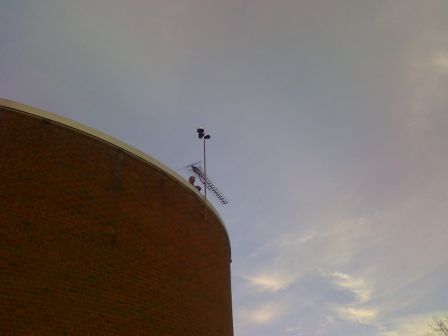
On AVS, I read about an amp made by a shop called Kitz Technologies in Wisconsin. It was the KT100VG, which was supposedly very well rated for its VHF performance. Looking at the specs, this amp had variable gain from 0-20 dB, but a noise figure of 1 dB or less. I sat on it for a long time, and finally made the decision to buy it. When I did, I noticed there was now a KT200, with a fixed 24 dB gain but an astonishing 0.4 dB noise figure. I couldn't say no to that, so I spent the extra money and got the KT200.
The first thing I noticed when I got it, was that I didn't know it had arrived. As I was living in UVA housing, I have a little PO Box to get my mail other than packages, for which I receive e-mail notices. I was waiting a really long time for a package notice, then one day decided to check my PO Box. Sure enough, it had fit in the PO Box.
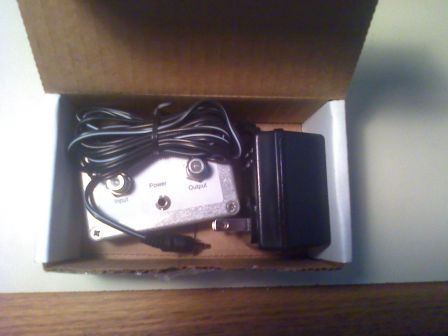
And indeed, it's tiny! Here are some pictures of the amp and power brick.
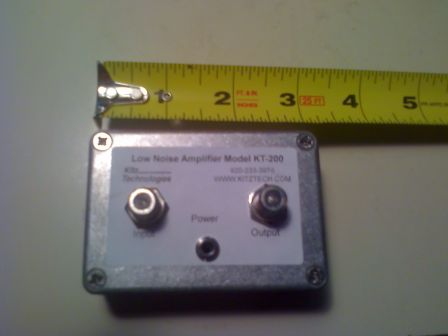
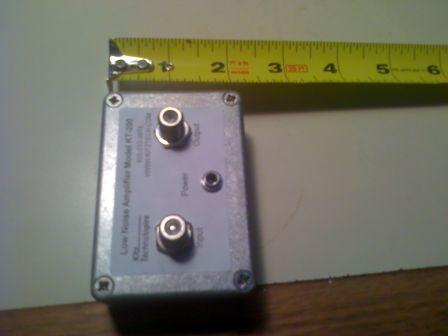
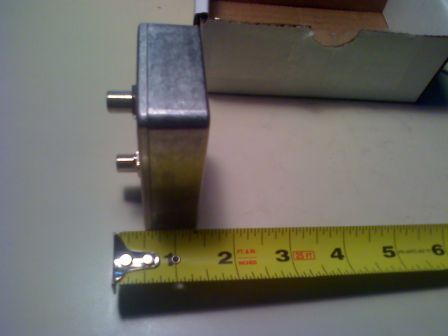
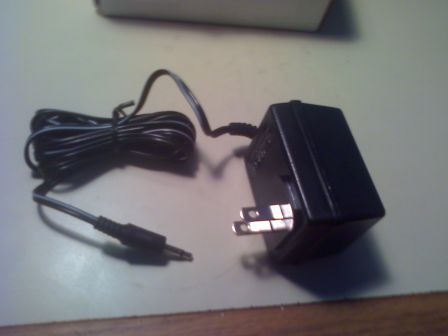
It's also extremely light. Opening it up, the soldering is very nicely done and it's obvious why it's so light. (Apologies for the blurriness of this picture.)
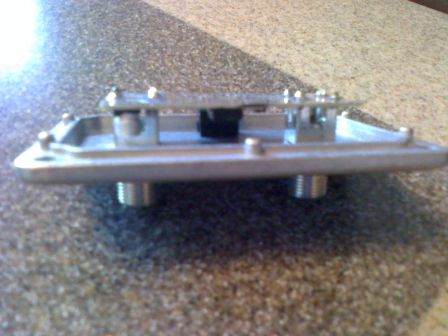
My first test was to try hooking it up in my UVA apartment and try to lock in WVPT-DT2 on channel 11. However, last time I tested it had been in the winter, and there were now leaves on the trees. My testing without the amp indicated that I had lost 6-8 dB of signal because of the leaves. As such, the channel 11 signal would no longer decode, even with the amp.
So, I instead decided to do a side-by-side test with the Radio Shack amp in the attic at home. It claims to provide 26 dB of gain, versus the 24 dB of the KitzTech, but with no statistics given on the noise figure. I've previously heard that the noise figure is around 2.5 to 3 dB for the Radio Shack, but I cannot confirm that. But the antenna system on the roof is a Winegard PR-8800 for UHF and a Winegard Y5-2-6 for VHF. WSET-13 is being received through the Y5-2-6 even though it is a low-VHF antenna.
Anyway, I grabbed my spectrum analyzer and disconnected the distribution system from the amp. The Radio Shack amp was hooked to the analyzer and measurements were taken. Then, I unhooked the RS amp and replaced it with the KitzTech. Again, measurements were taken. Here are the results.
| SNR/MER (dB) | Power (dBmV) | ||||
| RS | KT | Station | RS | KT | Notes |
| 20.7 | 21.2 | WBRA (3) | 9.9 | 14.0 | |
| 30.3 | 30.5 | WSET (13) | 11.8 | 9.5 | |
| 31.7 | 32.7 | WFXR (17) | 10.3 | 12.8 | |
| 29.1 | 29.5 | WDBJ (18) | 8.9 | 12.7 | |
| 35.6 | >36 | WWCW (20) | 21.3 | 24.8 | |
| 18.9 | N/A | WDRL (24) | -8.8 | -10.8 | Signal is not level, not a good indicator. |
| >36 | >36 | WSLS (30) | 12.4 | 4.1 | |
| 27.0 | 27.4 | WPXR (36) | -1.2 | -2.7 | |
What we can see here is that the actual raw signal power was all over--some signals got stronger, and others got weaker. The biggest improvement in raw power was WBRA which gained a full 4.1 dBmV. The biggest loss, confusingly to me, was WSLS which lost a whopping 8.3 dBmV. I'm not sure why that number is so large, as it seems rather out of place.
What's more important, and more consistent, is that the MER went up in almost every case except WDRL, where it fell below decoding. The noise floor is very high around WDRL and so I would guess the slight loss in received power caused it to fall below the noise floor. But as far as the rest, all of the stations showed increased MER. At the low end, WSET gained 0.2 dB, and at the high end, WFXR gained a full 1 dB. (My Sencore analyzer maxes out at 36 dB MER, so there's no way for me to know what impact it had on WSLS.)
I wish I had been able to test it against the CM7777. Maybe next year, if I get my amp back, I can do such a test. Also, if it wasn't so hot in my attic, I'd climb back up there and test it again, but with a third category for what the signals look like without either amp.
If you only need about 0.5 dB worth of improvement, then you probably need to focus on your antenna system more than a different amplifier. Is it worth the money to replace an existing amplifier? Probably not, but if you're in the market for a new one, I certainly don't see anything wrong with a small, light-weight, well-shielded, and well-functioning amplifier like the KT200.


Comments
Interesting that you mention this, Trip. I just acquired and installed a Research Communications 9262 LNA. Like the Kitztech it claims 0.4dB NF. Unlike the kitztech it can be coax powered (although I think kitz has a model which is coax powered) and it has a cutoff at 700MHz. The 9262 model does 2-51 which means that it is perfect for USA DTV folks, but unsuitable for Canadians (or Mexicans). I replaced my 7777 with the research comms amp. Prior to this I had an Antennacraft 10G212. The reason I had the 10G212 is because the 7777 overloads easily but the AC 10G212 does not. We had full power WMBC 63 analog right next door in Newton which thankfully went dark and moved to Montclair co-located with WNJN I believe so I couldn't have used the 7777 until after the DTV transition was over.
Initial test indoors were very promising. I was locking and receiving stations which previously were not lockable at all. This was with a little 19 inch telescoping whip. We got some great weather on Saturday so I climbed tower 1 at the N2RJ QTH to install it.
Results were astounding. Remember that little problem I had with WNYW? Well, not anymore. With one 4228A (old style) I got no lock on WNYW. With two ganged CM4228 and the 10G212 I got a lock but more cut-out than cut-in. With the 7777 I got a lock and drop outs maybe once every 20-30 seconds during the day and once a minute at night. Now with the RC9262 I get WNYW solid, with maybe 1 drop out every 2 hours during the day and no drops at all during the night. I will probably mount the antennas a bit higher (right now they are at 65ft) to clear the trees better.
Most other stations are now at or close to 100%. I can even get WASA-LP and WNET 13 which are both running low power.
The downside of all of this? The RC preamps are quite expensive, especially considering that you have to order them from the UK. 117GBP shipped is the system total including the preamp, power brick and weatherproof box. Add $5 for an AC plug since it doesn't come with one. I guess you can substitute locally obtained components for the weatherproof box and power inserter but that doesn't take the price down much. In the end GaAsFET preamps are pricey. But are they worth it? LIke you said, it depends. I do disagree though that antenna improvements negate the need for a good low noise preamp. Sometimes there's only so much you can do antenna wise. In my case I have two stacked 8 bays on a tower and I am already 800ft AMSL. The preamp absolutely can help out.
With the GBP and Euro on the downward trend, maybe the RC preamps may be a bit more accessible to Americans. I certainly am very pleased with mine, even though I am working to improve my antenna system I think that the RC preamp has made a very significant difference.
I will add that I have used and currently do use GaAsFET preamps for ham radio use for VHF/UHF DXing. They definitely do make a difference. I would also like to get into EME and for that a preamp is a must.
Glad to hear! How much of an improvement do you think it is?
And yes, there's a power-injected version of the KT200, but I don't need a separate power injector.
You know what, I'm going to e-mail you. (I have your address from when you sent me the WNJJ-LD capture.)
I ran the cascaded noise spreadsheet over at digitalhome.ca and it theoretically gave me 1.43 dB improvement over the 7777. More or less as expected. 3.91dB vs 2.48dB. Real world performance? Hard to say since I haven't ran any test equipment on it. I might be able to though. I'll ask a few folks if they'd help me in thet regard.